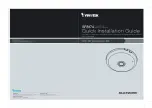
Commands and Syntax
Motorola, Inc.
549453-001-00-a
Page 8 of 51
C
C
o
o
m
m
m
m
a
a
n
n
d
d
s
s
a
a
n
n
d
d
S
S
y
y
n
n
t
t
a
a
x
x
C
C
o
o
m
m
m
m
a
a
n
n
d
d
H
H
i
i
e
e
r
r
a
a
r
r
c
c
h
h
y
y
The Tut Command Line Interface (CLI) implements a hierarchical command structure. Commands are organized as a
high-level command keyword related to a particular function of the device with sub-commands related to sub-
functions.
You may move down in the command hierarchy by entering root keywords and sub-keywords followed by the enter
key. Your current level in the command hierarchy is referred to as the “command context.” The top-level context is
referred to as the “root command context.” You may move up to the previous command context by using the exit
command. The command prompt displays the current command context.
Full commands may be entered at the root command context. For example:
system> interface dsl enable port1
You may also move down levels in the command hierarchy, which allows you to execute commands with less
repetitive typing.
For example:
system>
interface
system:interface>
dsl
system:interface.dsl> enable port1
system:interface.dsl> enable port2
system:interface.dsl> enable port3
system:interface.dsl>
exit
system:interface>
exit
system>
A
A
d
d
m
m
i
i
n
n
i
i
s
s
t
t
r
r
a
a
t
t
i
i
v
v
e
e
C
C
o
o
m
m
m
m
a
a
n
n
d
d
s
s
Most commands discussed in this guide are administrative commands, which change the configuration of the system
or affect the operation of the system. These commands can only be executed from the
admin
account. Configuration
changes take affect immediately and are recorded in non-volatile memory (NVRAM) in the default mode.
Alternatively, you may choose not to record changes in NVRAM. In this case, changes will need to be committed
before rebooting the system; otherwise the configuration will revert to the last saved configuration. If automatic
commit is enabled, or the configuration is manually committed, the running configuration will automatically be restored
if the system power cycles or is rebooted.
Show Commands
The
show
commands are used to view configurations, status and/or statistics. These commands can be issued from
either the
user
or
admin
account.
Global Commands
Commands that are available from any command context are called
global
commands. For example, the
help
command can be used whether you are at the root command context or down a few levels in the command hierarchy.
Global commands can also be used from either the
user
or
admin
account.
Note:
The default prompt is “system>”. If you set the system name using the “
system name
” command, the
prompt changes to the new system name.









































